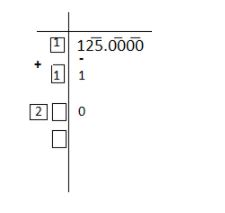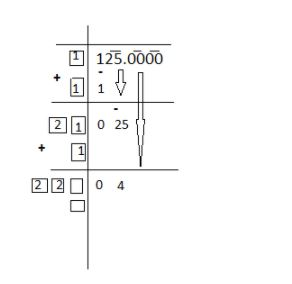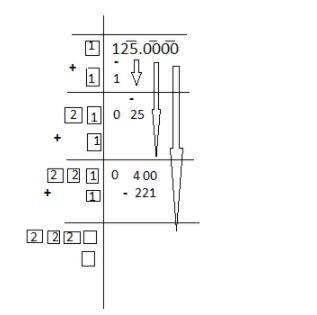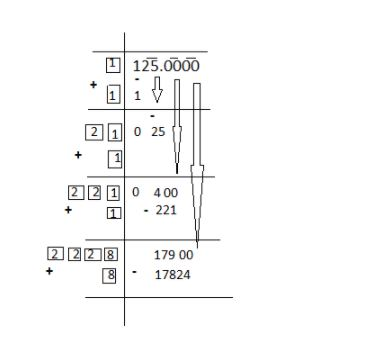
Find the square root of 125 by long division method ?
Answer
504k+ views
Hint: long division method of finding square root is helpful when we have to find the square root of a long number. As we all know that we can also write 125 as 125.0000. And we had to begin the question by pairing and then finding the greatest number whose square is less than or equal to the digits in the first group.
Complete step-by-step answer:
As we all know that 125 = 125.0000. So now let us pair 125.0000 from left to right.

Now let us begin solving the question step by step.
Step 1. First step is that we had to find the numbers which when multiplied give the same or the smaller number than the rightmost digit or pair of the question. Here it is 1 so we get 1 by 1*1.
Step 2. Now we had to write the numbers that we had multiplied on the right side and the number we got after multiplying on the left side. On the right side we had to add the numbers whereas on the left side we had to subtract.

Step 3. In the next step we had to first note down the next pair and then we had to find the other digit of the right side which we had to write with the value we get after adding the above right side value .
Step 4. Again similarly the value when multiplied with each other gives the same or the smaller number than the pair we had taken.
Step 5. So if we keep the right side value again as 1 than 21*1 = 21 < 25.
Now we had to follow step 3 again and we will get

Step 6. This step must be similar to step 3 and step 4.
Step 7. So if we keep the right side value again as 1 than 221* 1 = 221 < 400. Again we had to follow step 3 to solve it.

Similarly, as we had done above now also we had to do the same but this time if we put the value of rightside as 1 then a very small value we will get so we had to keep another number.
Step 8. Now if we put the value as 8 then 17824 < 17900 and the next step must be the same as we had done above.

Now this will go on and we will count the zeros after 125 till here we will come to know that the square root of 125 till two decimal places is 11.18.
Note: Whenever we come up with these types of problems we first of all start pairing from left to right and then for solving the question we would have to remember that on the right side we had to add the digits and on the left side we had to subtract the digits. There were other ways also to find square roots of any number but when it is mentioned that find square root by long division we had to follow the above steps which are explained in detail.
Complete step-by-step answer:
As we all know that 125 = 125.0000. So now let us pair 125.0000 from left to right.

Now let us begin solving the question step by step.
Step 1. First step is that we had to find the numbers which when multiplied give the same or the smaller number than the rightmost digit or pair of the question. Here it is 1 so we get 1 by 1*1.
Step 2. Now we had to write the numbers that we had multiplied on the right side and the number we got after multiplying on the left side. On the right side we had to add the numbers whereas on the left side we had to subtract.

Step 3. In the next step we had to first note down the next pair and then we had to find the other digit of the right side which we had to write with the value we get after adding the above right side value .
Step 4. Again similarly the value when multiplied with each other gives the same or the smaller number than the pair we had taken.
Step 5. So if we keep the right side value again as 1 than 21*1 = 21 < 25.
Now we had to follow step 3 again and we will get

Step 6. This step must be similar to step 3 and step 4.
Step 7. So if we keep the right side value again as 1 than 221* 1 = 221 < 400. Again we had to follow step 3 to solve it.

Similarly, as we had done above now also we had to do the same but this time if we put the value of rightside as 1 then a very small value we will get so we had to keep another number.
Step 8. Now if we put the value as 8 then 17824 < 17900 and the next step must be the same as we had done above.

Now this will go on and we will count the zeros after 125 till here we will come to know that the square root of 125 till two decimal places is 11.18.
Note: Whenever we come up with these types of problems we first of all start pairing from left to right and then for solving the question we would have to remember that on the right side we had to add the digits and on the left side we had to subtract the digits. There were other ways also to find square roots of any number but when it is mentioned that find square root by long division we had to follow the above steps which are explained in detail.
Latest Vedantu courses for you
Grade 11 Science PCM | CBSE | SCHOOL | English
CBSE (2025-26)
School Full course for CBSE students
₹41,848 per year
Recently Updated Pages
Master Class 9 General Knowledge: Engaging Questions & Answers for Success

Master Class 9 English: Engaging Questions & Answers for Success

Master Class 9 Science: Engaging Questions & Answers for Success

Master Class 9 Social Science: Engaging Questions & Answers for Success

Master Class 9 Maths: Engaging Questions & Answers for Success

Class 9 Question and Answer - Your Ultimate Solutions Guide

Trending doubts
Fill the blanks with the suitable prepositions 1 The class 9 english CBSE

Difference Between Plant Cell and Animal Cell

Given that HCF 306 657 9 find the LCM 306 657 class 9 maths CBSE

The highest mountain peak in India is A Kanchenjunga class 9 social science CBSE

What is the difference between Atleast and Atmost in class 9 maths CBSE

What is pollution? How many types of pollution? Define it




